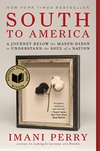South to America: A Journey Below the Mason-Dixon to Understand the Soul of a Nation
amazon.com
Saved by Lael Johnson and
South to America: A Journey Below the Mason-Dixon to Understand the Soul of a Nation

Saved by Lael Johnson and
In this hemisphere, the shifting borders of Texas, and the interests of its power brokers, make Mexicans, Central Americans, and Indigenous people part of both the history and present of Texas. But the numbers of Mexicans and Central Americans living inside of Houston increased dramatically during the labor shortages caused by the World Wars. The
... See moreIf America is to be salvific, it can only be so because underneath our skyscrapers lie the people who have tasted the red clay, the loamy soil. Lashed, hidden, running, captured. Crucified for gain, bloodying the soil. If their dreams can become “we” dreams, hope will spring. “Greatness” is such an egotistical and dangerous word. But in the land of
... See moreGalveston sank. Houston rose. Less than a year later, in January of 1901, the gusher came. On Spindletop Hill, oil shot out of the ground. The soil in most of Houston is black gumbo, dark heavy clay. When it gets wet, it stays wet. And it’s hard to work for farming. But something farther below yielded more. Eons ago, living beings—algae, plankton,
... See moreDreaming isn’t dead. It can’t be. We can do it anew. Me and you, both of us are required. I believe writing can be a moral instrument if it asks you to do more than read. Do you? How many times will you witness people being starved or worked to death, driven out of their homelands, the land blasted and lives destroyed, and be only quietly
... See moreWhile prominent people wielded power locally as well as internationally, working-class people sought their fortunes in Houston. Black people from rural areas migrated to the city during the Great Migration, making it the Southern city with the largest Black population, larger than that of Atlanta or New Orleans, by 1940.
By the 1890s, Texas was settled into the fabric of the nation, or mostly anyway. A Jim Crow industrialist class ruled. Texas wealth was concentrated in the port city of Galveston. But in 1900, Galveston suffered the deadliest natural disaster in US history, a hurricane that left somewhere between 6,000 and 12,000 people dead, a fourth of the people
... See moreToday Houston is one of the most diverse and cosmopolitan US cities. Anglos, White people who are not Latino make up 24.6 percent of the population. African Americans make up 22.5 percent, and the Latino population is 44.8 percent of the city. Asian Americans make up nearly 7 percent of the population, and Houston has the largest Nigerian
... See moreThis is also the burial site of Marie Laveau, the mythologized voodoo queen, who was such a shapeshifter that I can hardly imagine how to tell you a story about her that I know is true beyond the fact that she was once a real person. The first mayor of New Orleans, Jean Étienne Boré, is interred there as well. He is the man who first granulated
... See moreBras-Coupé was an African king enslaved in New Orleans. He was, according to the stories, striking and heroic. He danced in Congo Square, with many other enslaved people, on weekends. And everyone, from all points on the color line, admired his grace and beauty. But once he fled the plantation, his captivating movement and dignified posture were
... See more